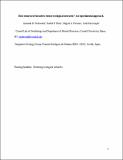Por favor, use este identificador para citar o enlazar a este item:
http://hdl.handle.net/10261/116766COMPARTIR / EXPORTAR:
 SHARE SHARE
 CORE
BASE CORE
BASE
|
|
| Visualizar otros formatos: MARC | Dublin Core | RDF | ORE | MODS | METS | DIDL | DATACITE | |

| Título: | Does removal of invasives restore ecological networks? An experimental approach |
Autor: | Rodewald, Amanda; Rohr, Rudolf P. CSIC ORCID; Fortuna, Miguel A. CSIC ORCID; Bascompte, Jordi CSIC ORCID | Palabras clave: | Birds Evenness Exotic plants Honeysuckle Invasive Nest survival Predation |
Fecha de publicación: | 2015 | Editor: | Springer Nature | Citación: | Biological Invasions, 17(8): 2139-2146 (2015) | Resumen: | Anthropogenic disturbance can alter the structure of ecological networks in ways that have population consequences. For example, bird-plant networks in forests surrounded by urban land were more likely to be dominated by strong interactions (i.e., less even in strength) than networks in rural landscapes, and these asymmetric interactions depressed avian nest survival. Based on this prior research, we hypothesized that invasion of urban habitats by exotic plants was the underlying mechanism driving changes in network structure. We tested this hypothesis using an in situ experiment where exotic Amur honeysuckle (Lonicera maackii) was removed from replicated 2-ha forest plots and compared bird-plant networks among urban removal forests, urban control forests dominated by honeysuckle, and rural forests with little honeysuckle. From 2005 to 2011, we surveyed densities of understory-nesting birds and nest predators, recorded information about nest location, and monitored nest survival. For each year and site network, we calculated evenness of interaction strengths. Despite post-removal vegetation resembling that in rural forests, removal of exotic honeysuckle did not restore network structure. Evenness of interactions between birds and plants was greatest in rural forests and least in urban control plots. Nest survival increased with evenness across all sites, but the relationship was strongest within urban removal plots, which had the lowest overall nest survival rates. Even though invasion by honeysuckle was a plausible driver of urban-associated network shifts in previous studies, the experimental removal suggested that factors other than invasion were responsible for network changes or that our system experienced hysteresis or time lags. Our study suggests that restoration of ecological networks may be more challenging than anticipated. | Versión del editor: | http://dx.doi.org/10.1007/s10530-015-0866-7 | URI: | http://hdl.handle.net/10261/116766 | DOI: | 10.1007/s10530-015-0866-7 |
| Aparece en las colecciones: | (EBD) Artículos |
Ficheros en este ítem:
| Fichero | Descripción | Tamaño | Formato | |
|---|---|---|---|---|
| Rodewald_2015.pdf | 114,19 kB | Adobe PDF |  Visualizar/Abrir |
CORE Recommender
SCOPUSTM
Citations
19
checked on 12-abr-2024
WEB OF SCIENCETM
Citations
16
checked on 29-feb-2024
Page view(s)
248
checked on 19-abr-2024
Download(s)
219
checked on 19-abr-2024
Google ScholarTM
Check
Altmetric
Altmetric
NOTA: Los ítems de Digital.CSIC están protegidos por copyright, con todos los derechos reservados, a menos que se indique lo contrario.
